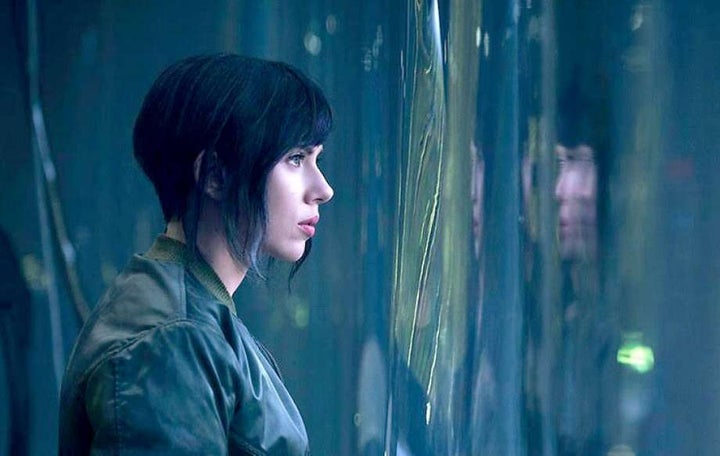
Scarlett Johansson as Major, Paramount Pictures
In the opening sequences of Rupert Sanders’ new film Ghost in the Shell, a woman lying on a lab gurney gasps for air as a reassuring voice tells her, “Just breathe!” This is the birth of a female cyborg (played by Scarlett Johansson), a hybrid creature with a synthetic shell of a body, a human brain, and a “ghost” or soul.
Her birth ― with her floating nude figure covered in dripping white liquid — has echoes of the acclaimed 1995 anime version of Ghost in the Shell directed by Mamoru Oshii based on the manga by Masamune Shirow. Both film versions are long way from the dramatic creation of the robot Maria in Fritz Lang’s iconic 1927 silent film Metropolis with its flashing electricity and floating rings or the creation of a companion for the Monster in James Whale’s now campy 1935 film Bride of Frankenstein where the bride’s bandages are dramatically unwrapped and Henry Frankenstein cries out ecstatically, “She’s alive!”
The birth scenes may be different but some of the main themes in these films and others, including Blade Runner and Ex Machina, are very much the same. When human beings are artificially created using technology, what happens to our notions of human identity? What is the nature of these new creatures that blur the distinction between the artificial and the real? What does it feel like to be a robot or synthetic creature?
Major, the cyborg woman also known as Mira Killian in the new Sanders film, was designed as an anti-terrorist agent in Section 9, and is tormented about the nature of her own identity. She looks at herself, stares at her damaged hand with its exposed mechanical innards, curiously touches the face of a human woman, and hunts up information about her own mysterious origins.
Scarlett Johansson has a tough assignment: she has to put her own stamp on the role of this simulated woman who is both powerful and vulnerable. In the film, she mostly displays a kind of stoicism, aside from an occasional small smile when Batou says he has her pegged as a cat person rather than a dog person, and she rarely shows even a flicker of emotion other than fierce intensity in the film’s many fight scenes. More memorable are the anguished cries of “Help me!” by the gynoids in the original 1995 film’s follow up, Ghost in the Shell 2: Innocence (2004) where the captured girls groomed to be sex slaves turn murderous before self-destructing. Still, Johansson brings to the role her signature ability to be both blunt and enigmatic so that we imagine her to have hidden sensitivities we do not see.
Mira/Major does make some poignant admissions, but usually with a poker face. When Dr. Ouelet (played by Juliette Binoche) warns her, “You’re not invulnerable. I can’t protect you,” and also tells her, “You’re what everyone will become one day,” Major says, “You don’t know how alone that makes me feel.” ( In the 1995 film, after diving down deep into water, she says a little more: “I feel fear, cold, alone,” and adds that sometimes, “I even feel hope.” )
As an actress, Johansson has had her own identity issues with this film. She’s had to deal with the fact that the film’s creators have been roundly criticized for not casting an Asian actress in Major’s role. She’s also had to deal with the paradoxes of playing the role of a robot: How do you convey that you are artificial yet also show some signs of humanity? How do you show a sense of individuality when you are an imitation of a real human being? (Adding a surreal twist , a British man in 2016 created his own robot double of Johansson herself.)
Like the birth scenes, Sanders’ Ghost in the Shell is haunted by other ghosts of films past. The film’s CG images of a futuristic city have echoes of earlier cinematic sci-fi cities seen in Metropolis and Blade Runner’s Off-World Colony set in 2019. But what works specially well in the new film are the mammoth holographs of female figures amidst the high rises ― towering females and mannequins that may be advertisements and eerie, spectral reminders of this highly synthetic world.
Another ghost is the theme of technology and its worrisome impacts. In the 1995 Ghost in the Shell, a blonde-haired robotic woman lying on a lab table utters ominously, in a male voice, “Humanity has underestimated the consequences of computerization” (the “woman” is actually the menacing Puppet Master in the film). Ghost in the Shell 2017 reminds us once again that in our increasingly digital universe dominated by computer code, humanity itself is under siege.
The film — with its explosions and violence, its menacing spider tank, its futuristic urban scenes, its meditations on technology — does not open up much new territory. But near the end it becomes surprisingly effective when Major meets and later, embraces the woman who may be her original mother (movingly played by Japanese actress Kaori Momoi). It is at this moment where she comes closer to discovering who she once was and it may give her some closure and peace.
Near the end she seems to finally cast off her uncertainty. When she again says, “My name is Major and I give my consent,” she really seems to have agency. Likewise, she is assured when she says fatalistically but firmly, “I know what I am and what I need to do.” Her identity as a cyborg with a soul may still remain problematic, but for her — and for now ― she has gained a sense of self.
